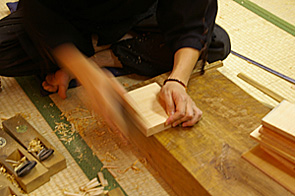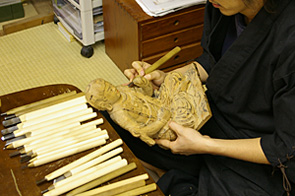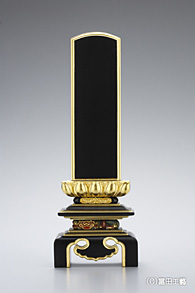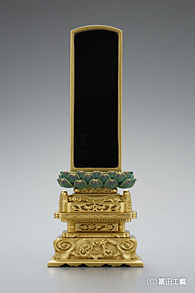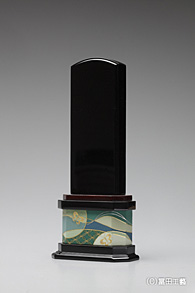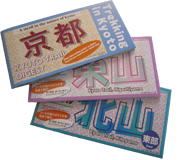Arts & Performances
Kyoto is a birth place of traditional arts, crafts and performances of Japan, and has been maintaining its tradition with the coming of the new age. Here GTK'd like to introduce the monthly art highlights, museums, creators etc.
Art Feature Vol.3
Mutsumi Tomita is a Busshi, sculptor of images of Buddha, and the 3rd generation of Tomita Kogei Company in Kyoto.
The images of Buddha (hereafter Butsuzo) The sculptor of images of Buddha (hereafter Busshi)
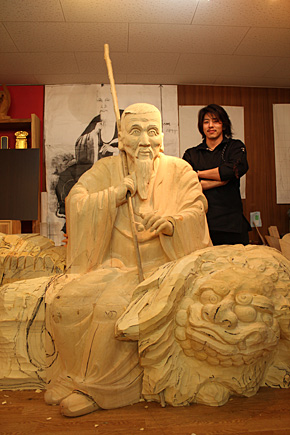
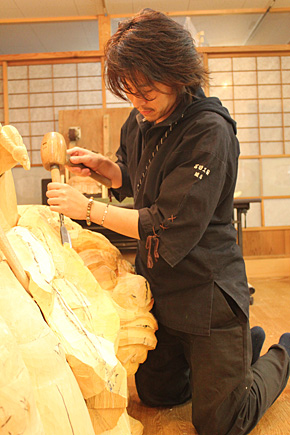
Q & A
- Firstly, are you Buddhist? Do you need to study Buddhism or to be Buddhist in order to be a Busshi?
- Yes, I am, but you don't need to be Buddhist and actually there is not any such rule. However, I think, you need to learn and understand Buddhism and the meaning and faith of each Butsuzo. I studied the Rinzai Zen sect of Buddhism at Hanazono University, established by Myoshin-ji Temple.
- Do you get orders for Butsuzo only from temples? Do you also have the personal customers?
- We get orders from both.
- Do you experience any special feelings when you carve the tree?
I have some special feelings for the tree I use. The tree used for Butsuzo undoubtedly had been living longer than us. The tree was chosen for Butsuzo, not for firewood. I can't help but appreciate the meeting with the tree and the chance to carve for Butsuzo.
- The product called Go-ihai is mainly displayed at the factory and on the website of Tomita Kogei Company. What's Go-ihai and why is it so important in Buddhism?
Go-ihai is recognized as the most close for the object of worship, and the Buddhism name after people died called Kaimyo is carved on the surface of Go-ihai. Japanese people have been respecting their ancestors and this custom can be said the Japanese religion. To treat Go-ihai with care is to respect and appreciate our ancestors.
- Which Butsuzo would you like to recommend seeing in Kyoto?
I'd like to recommend Sanjusangen-do Temple, located at Higashiyama-shichijo.
(http://sanjusangendo.jp) This temple is famous for 1,000 statues of Kannon with 11 heads and 40 hands which are niched in the main hall. These Kannon are called "Juichimen-senju-kannon". I'd like to tell you one interesting thing about them.999 Kannon out of the 1,000 Kannon including one big Butsuzo which is said to be the same size as the real Buddha(15.7 feet tall, 7.8 feet seated) are said to have been produced by three teams of Busshi in the 13th century. The schools were In school, En school and Kei school. The popular Busshi in the Kamukura era, Unkei and Tankei, belonged to the Kei school and thus followed the custom of adopting their school's name.
The In and En schools had been based in Kyoto, and so patronized by court nobles. On the other hand, the base of the Kei school was in Nara and had no such rich sponsors. When this temple was burned down in 1249, the task of reconstruction was given to the three schools. This was a golden chance for the Kei school to show their great skill.
I feel the Kannon carved by the Kei school look strong while In and En schools' look gentle.
Warriors preffered the Butsuzo by the Kei school, and later the Kei school came to be patronized by the Shogunate.
The main Kannon, which is niched in the center, was produced by the Kei school.(about 7.8 feet seated)
You can see the difference in the styles and the competition between the schools in the 1,000 Kannon of this temple.
Tomita Kogei
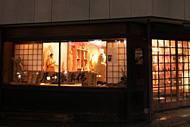
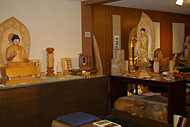
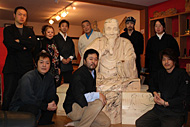
View Art feature in a larger map
- Tomita Kogei
- Higashiyama-ku Kyoto-city
- 11:00 ~ 18:00
- Closed on Sunday
- kyoto-ihai@tomita-k.jp
- Highlights of Art
- Museum Information
- Art Feature

- Art Feature Vol.3
- Busshi

- Art Feature Vol.2
- English haiku poet

- Art Feature Vol.1
- Lacquer crafts painter
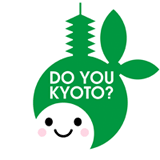
![]()

